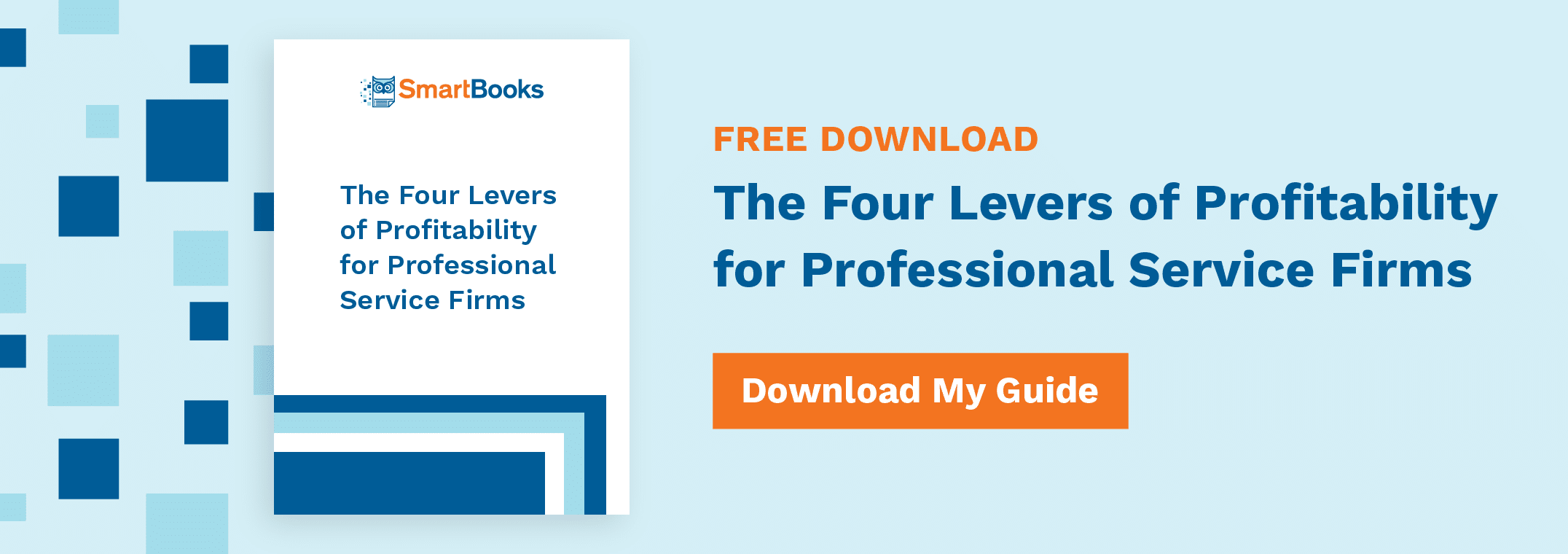How Employee Utilization Drives Profitability for Professional Service Firms

Across the professional service industry, firms of all sizes have a perennial and ongoing goal: Get more productive!
And it turns out, someone is listening. The Wall Street Journal reported worker productivity in 2018 increased at an annualized and seasonally adjusted rate of 2.9% in the second quarter from the prior three months—the largest growth in productivity since Q1 2015. But “productivity” as a KPI (key performance indicator) isn’t easy to measure. Instead, firms can look to another formula to get an idea of how efficient and productive their teams are: employee utilization.
Utilization Benchmarks
Employee utilization is a metric detailing what percentage of an employee’s time is used to deliver service to clients and thus generate revenue. The higher the utilization rate, the more revenue and profit the employee generates for the company.
Here’s an easy way to look at it. Of the standard 40-hour work week, how many of those hours involve employees delivering direct, billable services to clients? Most professional service firms end up with utilization targets around 80%, which shakes out to 32 hours of billable client work, with the remaining 8 hours devoted to internal meetings, training, or vacation time. Of course, there are some exceptions to this – think high-powered law firms that demand 100% utilization from night and weekend work – but 80% is the standard that most businesses follow.
Utilization as a Measure of Profitability
While some firms take a deep dive into employee utilization by analyzing worker performance at the individual level, and that is important in managing operations, the calculation doesn’t need to be so complicated.
As a metric, utilization itself is pretty easy to track. All you need to do is divide each employee’s billable hours by the total number of hours they are paid to work in a given week (40 hours for a full-time employee). A 5% difference in utilization is 2 hours per week or 8 hours per month per employee. From there, it’s easy to fold in the company’s financials to get a top-level view of utilization-driven profitability.
It’s easier than it sounds! Professional service firms typically bill clients by the hour or base fixed fees on an expected average number of hours to deliver a service. They tend to have operating costs that are fixed and predictable and don’t vary based on the amount of service delivered in a particular month. Think payroll, rent and IT. With these recurring expenses in mind, it’s easy to see how increasing utilization rates (and thus increasing revenue per employee) represents incremental profit, as an extra few hours of revenue drops straight to the bottom line as profit. Conversely, decreasing utilization rates and not having those extra few hours of revenue detracts from the firm’s profitability as less revenue needs to pay the same expenses. If a firm has 8 billable employees, a 5% change in utilization represents 64 hours of revenue per month. If it prices at $150 per hour, that is $9,600 per month of profit gained or lost. In this way, utilization rates have a direct correlation with profitability for professional service firms.
Improving Utilization Rates
First and foremost, the company should examine how much time is spent on non-billable activities and see whether these workflows could be optimized. Regular meetings are important—but do you really need to gather the whole team for a weekly rundown? Every non-billable hour logged can detract from short-term revenue, so it’s important to look at each workflow and make sure it adds value.
Note that this “downtime” shouldn’t necessarily be minimized! There’s certainly value in effective training and productive meetings, and these internal systems shouldn’t be cut out for the sake of short-term increases in utilization if doing so reduces long term efficiency.
Preventing Worker Burnout
Thanks in part to the natural inclination toward higher productivity and stronger utilization rates, work overload and employee burnout may become serious concerns. If managers push too hard to bump up utilization rates, workers may have trouble keeping up.
While better utilization rates make the company more profitable in the short-term, the well-being of the company’s team shouldn’t be sacrificed in the process. Consistent utilization rates depend on consistent teams that operate well in their roles.
Worker Utilization Strategies
Utilization rates are all about efficiency in both employee time and employee responsibilities. Consider that each worker has different capabilities that contribute different things to the organization. Typically, the most senior technical workers in any organization have the most flexibility. They can do high-level work when needed, and they can find lower-level tasks to keep them occupied when high-level work isn’t available. They’re also more able to find new ways to add value to the organization when billable work is limited. On the other hand, junior employees have more limited skillsets and lack this flexibility.
With this in mind, professional service firms can boost productivity with one simple workflow: assigning as much work as possible to junior employees to keep them engaged and fully utilized, while letting the senior staff have more schedule flexibility to take on new projects. This makes sense from a time management perspective, but it also helps keep workers engaged by letting them focus on tasks they’re comfortable with. Another report by Gallup found that workers who get to utilize their strengths every day at work have substantially better outcomes:
- 3x more likely to report an excellent quality of life
- 6x more likely to be engaged at work
- 8% more productive across the board
- 15% less likely to quit their jobs
It’s common for employee roles to evolve, so companies will need to keep tabs on their utilization rates and targets as these responsibilities shift. Utilization isn’t just about profitability—it’s about finding the perfect balance between billable work and internal coordination. Professional service firms should keep these ideas in mind as they set goals and take care not to sacrifice long-term worker engagement for short-term gains.
Interested in learning more about how to optimize profitability for your organization? Download our free guide below.
